Hot Chips: Google TPU Performance Analysis Live Blog (3pm PT, 10pm UTC)
by Ian Cutress on August 22, 2017 5:58 PM EST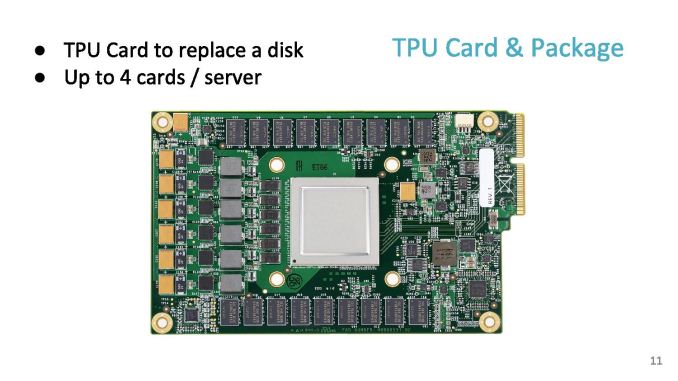
06:00PM EDT - Another Hot Chips talk, now talking Google TPU.
06:00PM EDT - TPU first generation is inference only accelerator
06:00PM EDT - 'Batch Size is an easy way to gain perf and efficiency
06:02PM EDT - TPU was a future looking product: in 2013, if everyone wanted to speak to their phone 2-3 minutes a day, it would take 2-3x current total CPU performance
06:02PM EDT - 'TPU project is an investment for when the performance is needed'
06:04PM EDT - Develop machine learning in terms of Tensor Flow, the idea is to make TPU easy
06:05PM EDT - After deploying convolutional neural network, it's interesting how small of our total workload it is
06:05PM EDT - TPU is an accel card over PCIe, it works like a floating point unit
06:06PM EDT - The compute center is a 256x256 matrix unit at 700 MHz
06:06PM EDT - 8-bit MAC units
06:06PM EDT - Peak of 92 T ops/sec
06:06PM EDT - DDR3 interfaces happen to be a bandwidth limit for the original TPU
06:06PM EDT - Not an ideal balanced system, but lots of MACs
06:07PM EDT - Chip size, 30% for buffer, 24% for matrix unit
06:07PM EDT - Software instruction set has 11 commands, five of which are the ones mostly used
06:07PM EDT - Average 10 clock cycles per instruction
06:08PM EDT - Dispatch 2000 cycles of work in one instruction
06:08PM EDT - In order, no branching
06:08PM EDT - SW controlled buffers
06:08PM EDT - Hardware was developed quickly, difficulty shifted to software to compensate
06:09PM EDT - Problem: energy/time for repeated SRAM accesses of Mat mul
06:09PM EDT - As each input moves across the array, it gets multiplied, then added as it move down the array
06:09PM EDT - Jagged timings, so systolic
06:10PM EDT - Can ignore pipeline delays by design
06:10PM EDT - First chips in datacenter in 2015, compared to Haswell and K80s
06:10PM EDT - Die size of TPU was smaller, TDP was smaller
06:10PM EDT - 2 limits to performance: peak computation and peak memory (roof-line model)
06:11PM EDT - Arithmetic intensity (FLOPs per byte) determines which limit you hit
06:12PM EDT - TPU is near peak use in roofline, but only two tests hit the roofline. Other tests hit the memory limit
06:12PM EDT - We thought users would be in the inference cycle limit when first gen was developed
06:12PM EDT - CPUs and GPUs are better balanced, but performance are a lot lower
06:12PM EDT - We built a throughput machine, but it's being used in a latency driven manner
06:15PM EDT - Perf/watt 80x compared to Haswell, 30x compared to K80
06:15PM EDT - Roofline plot says memory limited
06:15PM EDT - So improving TPU: moving the ridge point
06:15PM EDT - Change 2x DDR3 memory to GDDR5 for example, due to memory limit. Improves performance for certain tests
06:15PM EDT - Ends up 200x perf/W over Haswell, 70x over K80
06:17PM EDT - At a top level, the TPU succeeds due to the exercise in application specific design
06:18PM EDT - At a top level, the TPU succeeds due to the exercise in application specific design
06:18PM EDT - As TPUs go forward, we will also get to do backwards compatibility to see how a machine ages
06:18PM EDT - Flexibility to match NNs in 2017 vs 2013
06:18PM EDT - Single threaded deterministic execturion model good match to 99th percentile response time
06:18PM EDT - Apps in Tensor Flow, so easy to port at speed
06:18PM EDT - When you have a large 92 TOPs hammer, everything looks like a NN nail
06:18PM EDT - Run the whole inference model on the TPU
06:18PM EDT - Easy to program due to single thread control, whereas 18-core CPU is difficult to think about
06:19PM EDT - Makes it easy to mentally map problem to single threaded environment, e.g. AlphaGo
06:20PM EDT - In retrospect, inference prefer latency over throughput - K80 poor at inference vs capability in training
06:21PM EDT - In the DRAM, a small redesign improves the TPU a lot (solved in TPUv2
06:21PM EDT - 65546 TPU MACs are cheaper than CPU/GPU MACs
06:21PM EDT - Time for Q&A
06:22PM EDT - Q: What is the minimum size problem to get good efficiency on the TPU - what is the right way to think about that
06:23PM EDT - A: I don't have a complete answer, but colleagues have mapped single layer matmuls and got a good payoff, but the goal is neural networks with lots of weights
06:23PM EDT - Q: Does the system dynamically decide to run on TPU over CPU
06:23PM EDT - A: Not at this time
06:24PM EDT - Q: Precision of matmul?
06:24PM EDT - A: 8-bit by 8-bit integer, unsigned and unsigned
06:24PM EDT - A: 8-bit by 8-bit integer, unsigned and signed
06:24PM EDT - A: 8-bit by 8-bit integer, unsigned and signed*
06:26PM EDT - Q: Does google view sparseness and ever lower precision
06:27PM EDT - A: 1st gen does not do much for sparse-ness. Future products not disclosed in this. Reduced precision is fundamental. We'd love to know where the limit for training and inference is in lower precision
06:27PM EDT - Q: TPU 1 had DDR3, and GDDR5 study got a lot performance, did you build a GDDR5 version?
06:28PM EDT - A: No, but the new TPU uses HBM
06:30PM EDT - Q: How do you port convolution to GEMM? A: Discussed in papers and patents! There's two layers of hardware to improve efficiency
06:32PM EDT - That's all for Q&A. There was a TPU2 talk earlier that I missed that I need to look through the slides of and write up later.
06:32PM EDT - .


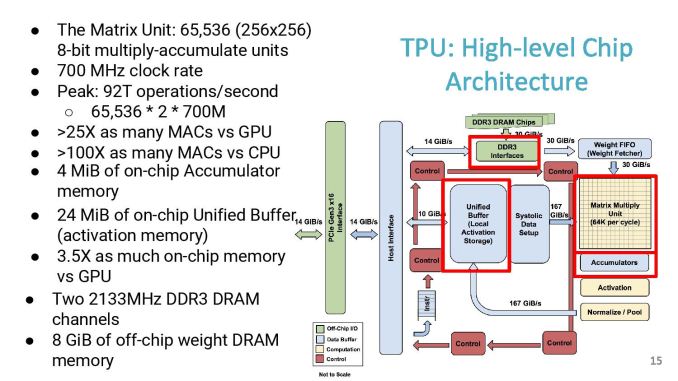
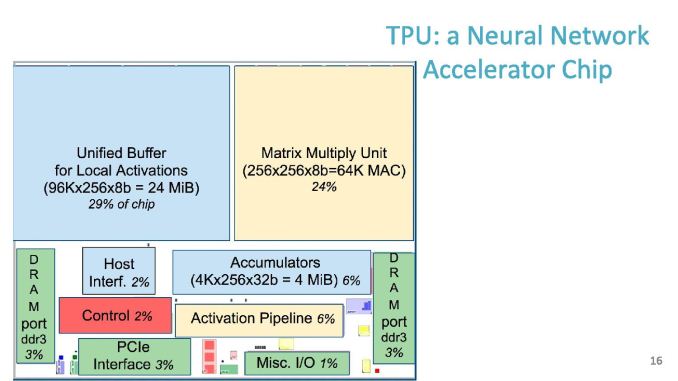
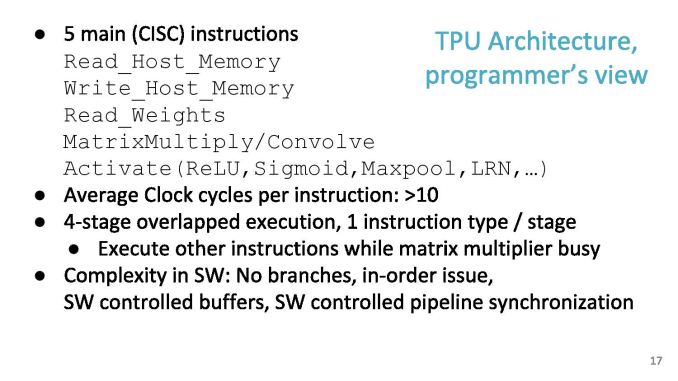
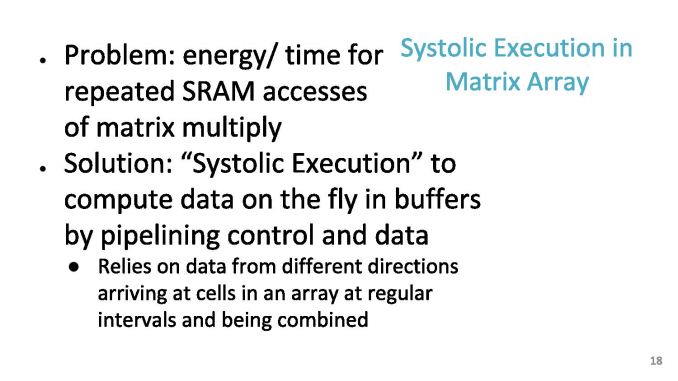
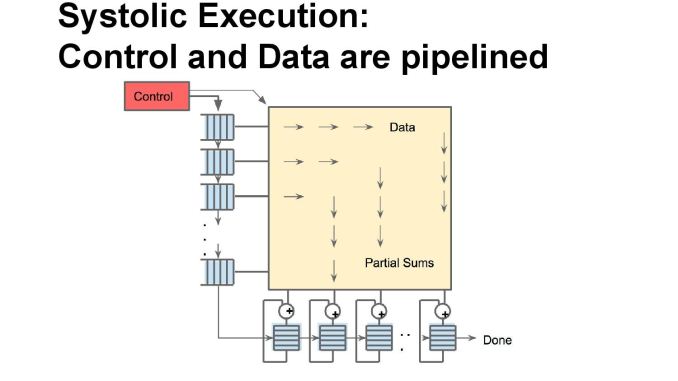

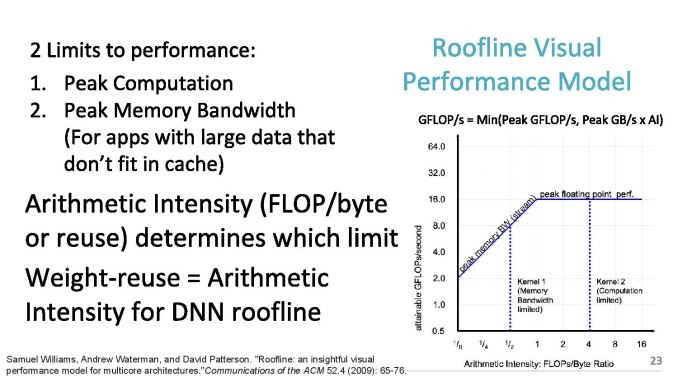

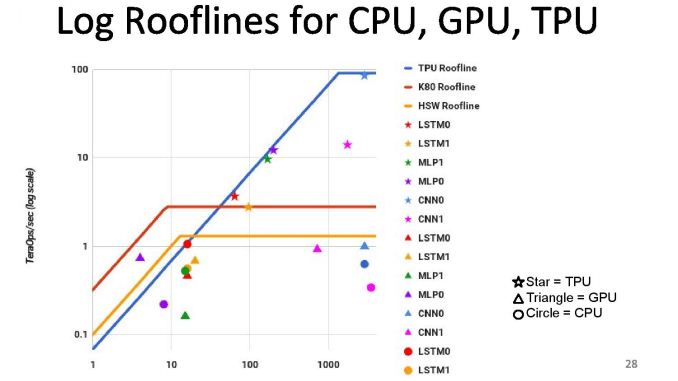

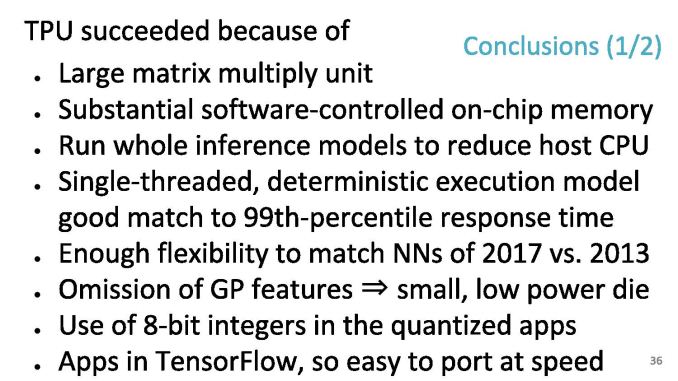
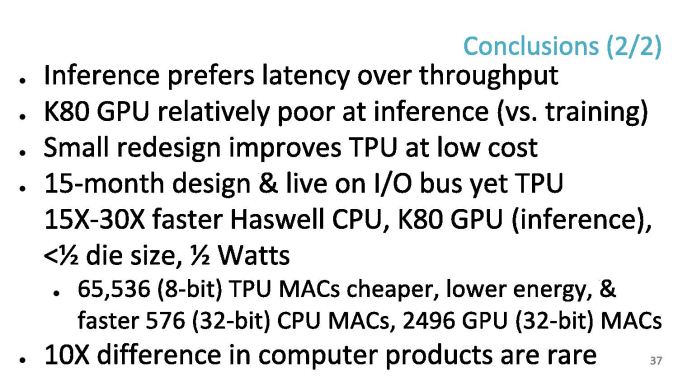








30 Comments
View All Comments
skavi - Friday, August 25, 2017 - link
price and power usagep1esk - Saturday, August 26, 2017 - link
I'm not sure about price: unlike Google, Nvidia enjoys massive economies of scale.tuxRoller - Sunday, August 27, 2017 - link
First, by not selling it.Second, by building an ASIC with a team of superstars (take a look at the authors of the original tpu paper on arxiv).
Third, let's see how things shake out once the volts hit the floor.
tuxRoller - Monday, August 28, 2017 - link
OMT, if you look at the ratios, the dgx1 is about 4x faster than k80 across various inference benchmarks.https://www.tensorflow.org/performance/benchmarks#...
Yojimbo - Monday, August 28, 2017 - link
From what I see, those are training benchmarks, not inference benchmarks.If the data were relevant (if it were inference data), one other thing to keep in mind would be that those benchmarks were taken in March 2017 with more recent libraries used than the tests from 2014 presented in Google's talk. One could not just equate the 2014 K80 results with the 2017 K80 results to extrapolate an accurate comparison of P100 performance with the TPU.
Yojimbo - Monday, August 28, 2017 - link
Oh, some other things to keep in mind.One is the low-precision capabilities of NVIDIA's newer cards. The P100 is not NVIDIA's best Pascal inference card, the P40 is. The P100 has double rate FP16 capability, but not special 8 bit integer capability. The P40 has quad rate 8 bit integer capability making it a good choice to compare with the TPU since the TPU uses 8 bit integers, as well. The K80's fastest mode is to use 32 bit floats.
Secondly, latency seems to be very important in inferencing. Most discussion of inferencing I have seen has discussed it as being a key metric. It seems odd to me that Google hasn't presented any latency comparisons. Maybe Google had a specific use in mind for these TPUs where the latency isn't an issue, but I think most likely the TPU was an experimental chip and latency was an issue in its practical operation. Ian did quote the presenter as saying "In retrospect, inference prefer latency over throughput" and "K80 poor at inference vs capability in training". NVIDIA came out and claimed their P40 could get twice the inferences per second as the TPU while maintaining less than 10 ms of latency, but I never saw any detailed explanation of that claim.
NVIDIA has to this point (Pascal generation) not convinced anyone to use their GPUs rather than CPUs for inferencing at any significant scale. I think Google uses mostly CPUs themselves. CPUs are latency optimized. Various people (Microsoft and Baidu, for example) are experimenting with using FPGAs for inferencing because they can maintain flexibility for different algorithms better than ASICs and supposedly do so with good latency. NVIDIA has supposedly improved their inferencing throughput and latency on their latest Volta generation GV100, but it remains to be seen if they actually convince anyone to use that card for inferencing.
HollyDOL - Friday, August 25, 2017 - link
I am really curious if this TPU platform has enough life force in it. I remember PhysX cards being a big thing and "everybody is going to have one"... and now the cards are long gone and only the software part remained, bought by nVidia...jospoortvliet - Tuesday, August 29, 2017 - link
Well Google has no intention to sell - they ARE the market and certainly big enough..Yojimbo - Tuesday, August 29, 2017 - link
They aren't the market. They are part of the market. They aren't even the biggest cloud provider. Amazon is. There are various big players and several of them are trying to design and build their own deep learning accelerators. There are also several startups that are trying to bring deep learning accelerators to market, including one that is now owned by Intel (Nervana). It doesn't look like there's anything really special about the TPU in the scheme of things. It's interesting, it's experimental and they are continuing to try to develop it, but various different companies are experimenting with things. I am sure Google has a lot more GPUs than they have TPUs.tuxRoller - Sunday, August 27, 2017 - link
So, is that TPU 2 write-up coming?If not, any chance at providing a link to the slides?